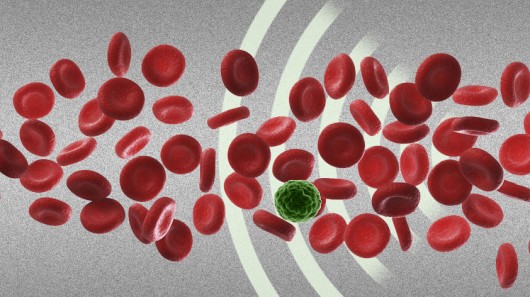
Researchers from MIT, Carnegie Mellon University and Pennsylvania State University have developed a novel technique of separating cells with the use of a gentle sound wave. The technique could potentially be used to screen a patient's blood, allowing medical practitioners to isolate rare tumor cells synonymous with diseases such as cancer.
The concept behind the new method involves placing two acoustic transducers on either side of a microfluidic device. Each transducer creates a sound wave, and when these waves impact on each other they combine to form a single static wave across a fluid channel running through the device.
As the abnormal cells pass through the fluid channel and hit the pressure points created by the sound wave, they are pushed to the side of the channel, away from the mass of ordinary cells accompanying them through the fluid. The amount of deviation created by the wave depends on cell characteristics such as size and density.
One of the benefits of using sound to differentiate cells is that it makes the separation process very gentle, posing essentially no risk to the cell, especially when compared to current methods of separation using chemical tagging or exposing them to stronger mechanical force – both of which could be harmful to the cells.
Previous experiments utilizing the sound wave method were ineffective, placing the sound barrier horizontally, thus only requiring the cells to pass through a single sound pressure point and limiting the amount that the cell deviates from the center of the channel. The new system pioneered by the team from MIT builds on this method, but instead orientates the sound wave at a slant. This subtle modification causes the cell to pass through multiple sound pressure points as it makes its way through the channel, causing it to drift to the outside in a much more obvious fashion.
Originally the device was tested with beads measuring between 7.3 and 9.9 microns. The results of the test were overwhelmingly positive, with the device separating the differing beads with 97 percent accuracy. The team then went on to test the ability of the device to detect abnormal cells, by having it separate breast cancer cells (with a typical size of 20 microns) from white blood cells (12 microns). Once again the device performed admirably, picking up 71 percent of the cancer cells.
Furthermore a computer simulation was created, allowing the team to ascertain what a cell's path would be through the sound waves when placed at different angles, factoring in the cell's density, compressibility, and size. The information attained from the simulation will allow the team to tailor the device to separate out specific cells based on their normative characteristics.
Looking to the future, the team have filed for a patent on the device, and hope to test the technique further on blood samples extracted from cancer patients in order to determine whether it will continue to perform with a high level of accuracy in a real-world situation. If the tests prove to be successful, the separation method could prove to be a safe, and efficient tool for doctors in determining the spread of a disease such as cancer.

 Previous page
Previous page Back to top
Back to top







